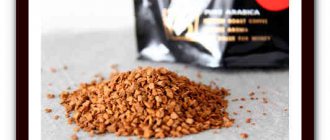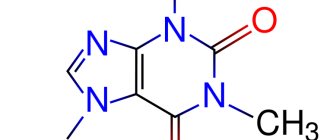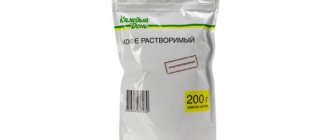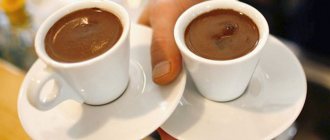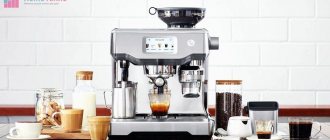What is the difference between freeze-dried coffee and granulated coffee?
The difference between freeze-dried and granulated drinks is their production technology. As described above, the production technology for powder and granular types is very similar. But the process of making a freeze-dried drink is completely different.
The essence of this process is this. First, a coffee decoction is prepared, which is frozen at a fairly low temperature. The product is then dehydrated in a vacuum at low pressure and broken into small pieces. The result is small pyramids that have the correct shape.
Read: Ristretto – a coffee recipe for pleasure
The best brands
It is impossible to say for sure which instant drink is the most delicious. Some people prefer bitterness in it, while others prefer sweetish sourness. The ranking of the best coffee brands includes:
- Bushido . This is a popular Japanese brand in Russia, distinguished by high quality. Price – from 800 rubles per 100 grams. It's a lot, but the taste of the coffee is worth it. The peculiarity of Bushido is its strength, pleasant consistency, rich aroma and chocolate aftertaste.
- Carte Noire . Many people fell in love with the drink due to its bittersweet aftertaste. The product range is represented by a wide selection. Carte Noire has soft, sour, sweet and bitter coffee. But all varieties are made from Arabica. Price – from 350 rubles per 100 grams.
- Grandos . This German-made freeze-dried product has recently gained popularity in the domestic market. It is distinguished by high quality and rich aroma. Another distinctive feature is the absence of flavors and additives in the composition.
- UCC . Japanese coffee representative with bright fruity notes in taste. The lack of bitterness has made the brand popular among young women. Its aftertaste is soft, mild, and its smell is pleasant and rich.
- Russian coffee shop on shares. The quality of this domestic brand is not inferior to foreign ones. This freeze-dried drink is as close as possible to the natural one in terms of taste and aroma characteristics. It contains no additional additives or flavorings.
Bushido
UCC
Moscow coffee shop on shares
Cart noir
When choosing instant coffee, be sure to pay attention to the packaging in which it is sold. It should be uniform and solid, without chips, cracks or other damage. Also check the expiration date of the product.
Calorie content of granulated coffee
Many people are interested in this question. The answer to this question can only make many people happy. The calorie content of granulated and any other type of instant coffee is only 2 calories.
But it’s a little early to rejoice. The thing is that additives are not taken into account. Many people like to add sugar, syrup, cream, milk, etc. to the drink. And these products are a source of calories. The exact caloric content should be found on the label of the product that is added to coffee.
Therefore, to the question: “What calorie content does coffee granules have?” It is necessary to take into account the products added to the cup, because they can be very high in calories.
| Additive | Calories (1 tbsp) |
| Sugar | 48 |
| Whole milk | 9 |
| Skim milk | 5 |
| Cream | 52 |
| Dry vegetable cream | 33 |
| Dry vegetable cream flavored | 40 |
| Vegetable drinking cream | 20 |
| Flavored vegetable drinking cream | 35 |
Types of instant coffee
Instant coffee is divided into three types, which for the average person are not very different from each other, however, each type (powdered, granulated and freeze-dried) is produced using a separate technology.
The article discusses only the two highest quality types. So, what is the difference between granulated coffee and freeze-dried coffee, which one is better to choose for morning preparation in order to cheer up and enjoy the same exquisite quality, taste and aroma?
Main differences
First of all, sublimated and granulated goods differ from each other in production technologies.
In addition, organoleptic indicators are striking. Freeze-dried coffee granules are large, dense, smooth, light brown in color, and pyromide-shaped. Granular has loose granules, similar to dry coffee lumps of a dark color. The aroma of the granules depends on the additives with which the dried extract was processed. Freeze-dried smells better due to the use of natural essential oils, but the true composition of the flavoring mixture is not known. A high-quality granular product may smell better than a cheap sublimate. Taste qualities also depend on the manufacturer, brand, and product line.
The price of freeze-dried coffee is much higher than granulated coffee, due to the expensive sublimation, raw materials used, and packaging. There is no point in packaging expensive goods in cheap containers. More often, glass jars are used for sublimate, which allow you to see the contents and protect well from moisture. The packaging can also be a gift, and regular plastic bags are also available. The latter are used to reduce the cost of products or low-quality, cheap goods.
So the main differences are:
- manufacturing technology;
- appearance, taste and aroma;
- cost of production.
Tips for choosing
There are no correctly outlined rules for choosing freeze-dried coffee, but you can rely on the main characteristics of instant coffee, which is necessary for a person who is concerned about both his own time and his own health.
It is best to give preference to glass containers or a special soft metallized type of packaging, which retain all the characteristics of freeze-dried coffee in reduced quantities. It's better not to take plastic packaging. Direct your attention to density.
Check the expiration date. A product that has been stored for more than 2 years is most likely full of preservatives that destroy the beneficial substances found in coffee.
If possible, it is necessary to study the condition of the coffee pyramids. Any of them should be quite large, not crushed. Broken integrity indicates broken nuances in production technology.
The cost also indicates the quality of the coffee, because it depends on the number of control steps in making the drink.
What is freeze-dried coffee?
Coffee is the favorite invigorating drink of millions. Most people prefer a natural, freshly brewed drink, but not everyone has the opportunity or time to prepare it at home. Freeze-dried coffee comes to the rescue, which, unlike other types of instant drinks, retains the natural taste and distinctive smell.
Production process
The difference between freeze-dried coffee and other instant types is the quality of the raw materials. No, high-grade Arabica beans are not used for its production, but the base is still coffee beans, not waste.
How is freeze-dried coffee made and how does it retain the smell of coffee beans? The creation of this type of drink, although not secret, involves a difficult step-by-step process that not every company is ready to go through. It’s even easier to produce granulated coffee on a huge scale and at a more attractive price.
Take this test and find out which drink is best for you.
- The coffee beans are ground and roasted.
- The prepared raw materials are filled with water and placed in special extraction batteries. There it cooks for a couple of hours. During the boiling process, steam escapes through pipes, where condensation appears. It contains essential oils that have been extracted from the seeds. The condensate is collected and then used to enrich the coffee with flavor.
- The boiled extract is placed in tanks, where part of the water evaporates and the raw material thickens, in other words, coffee bars are formed.
- They are placed in vacuum freezers and blast frozen. In this step, the coffee sublimates - the liquid evaporates and leaves an untainted extract.
- The dried mass is crushed to produce uneven particles in the form of pyramids. Now they are combined with evaporated essential oils to create a fragrant drink.
Now we know what freeze-dried coffee is and how it is created. It remains to figure out how it affects the human body and how freeze-dried coffee differs from granulated coffee, not counting the price.
How does sublimation and creation of the aroma of granules occur?
For this type of instant coffee, as for preparing natural coffee, whole high-quality coffee beans are roasted and ground.
- From the resulting finely ground powder, coffee is brewed in sealed vats for several hours.
- It takes so much time to extract essential oils from grains ground into flour that carry the aroma of the future instant drink. Together with the steam, they are removed from the tank through pipes, condensed and stored separately until the completion of the production process.
- The remaining coffee mass is sent for quick freezing. Extremely low temperatures and vacuum are created in specialized freezers. The process of completely instantly removing water from a cooking product is called sublimation.
- The dried solid concentrate obtained in this way is broken into dense small fragments with flat edges and irregular shape. When dissolved, they form the usual color, consistency and foam, creating the impression of natural coffee.
- At the last stage, the previously distilled essential oils are combined with almost finished granules. This treatment returns the specific coffee aroma and characteristic taste to the dry product. This technology allows you to retain more nutrients and almost as much caffeine as in natural coffee.
Coffee production line
History of appearance
The first attempts to produce instant coffee were made back in 1771 in Great Britain. The taste and aroma of the drink were very different from the natural one for the worse, so work continued to improve the quality of the product. The first technologies were patented at the end of the 19th century in three countries at once: France, America and New Zealand, but the revolution in the production of granulated coffee was carried out by the Nestle company.
Work on the product took almost ten years. The Wall Street Crash of 1929 led to a dire situation in the coffee market. The warehouses of Brazilian manufacturers were filled with unsold products, and falling prices brought companies to the brink of ruin. The director of Nestle at that time was Louis Dapple, who ordered the start of scientific work to create an instant drink with good taste.
Chemist Max Morgenthaler joined the development team. The scientist discovered that coffee with added milk and sugar, turned into powder, retains its taste better and lasts longer. As a result, Morgenthaler concluded that the secret to producing instant coffee was adding enough carbohydrates. It took two years to manufacture and install special equipment. The first batch of coffee was released only in 1938, and already in the 40s the Nescafe brand was sold in 30 countries.
Creator of Nescafe instant coffee, chemist Max Morgenthaler at work
